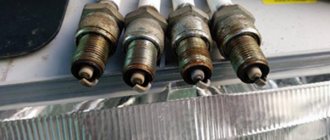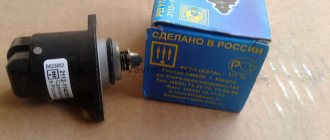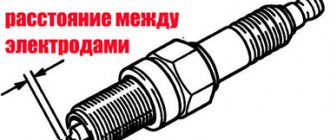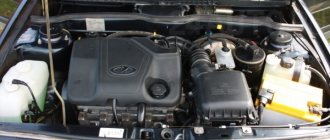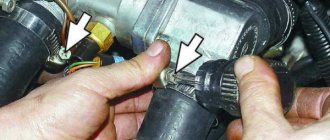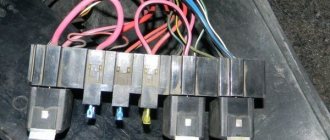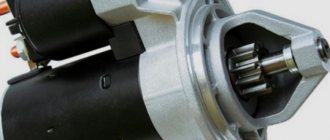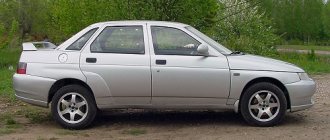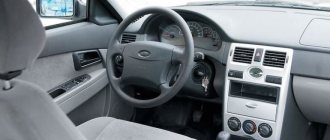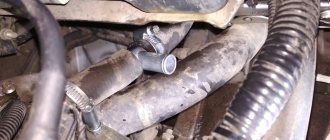Analysis of the causes of poor engine traction and possible repairs
Fuel filter dirty
This may be due to low-quality gasoline (containing various small debris) or infrequent cleaning of the fuel tank. In this case, you will have to completely replace the entire filter system.
Fuel pump diaphragm clogged
The cause of the blockage, as a rule, is low-quality gasoline. To clean it, just remove the diaphragm and rinse it thoroughly or blow it with air.
Malfunction of the sensor that controls air flow
This is the most common reason why the VAZ 2114 does not work.
It is worth periodically checking the operating condition of the air flow meter to avoid wasting time and money diagnosing the engine.
Air filter dust
The more the filter is clogged with dust, the less air flows to the engine, therefore, the thrust decreases. What can be done in this case? Ideally, the filter should be replaced with a new one, but if this is not possible, you should remove the filter, tap and blow to remove large debris (flies, dry leaves, insects).
Clogged injectors
If the injector nozzles are clogged, you will have to go to a service station for ultrasonic cleaning, or purchase a special cleaning liquid.
Auto mechanics advise purchasing only high-quality injector cleaning products, for example, Wynn's (Vince), LIQUI MOLY, Carbon Clean.
The procedure itself is quite simple: the cleaning agent needs to be poured into the gas tank. But this method can only help if the fuel system is not very dirty. An engine with several hundred thousand kilometers will most likely need a complete replacement of injectors.
Complete wear of the clutch disc
You can determine disk wear by the following signs:
There is another way to check wear: if you try to move off in fourth gear and the engine stalls, then there are no problems with the disc. If the engine continues to run, then the clutch disc will probably have to be replaced.
Poor spark plug performance
There are several signs by which you can identify a faulty spark plug:
Visual inspection of the spark plugs can also help identify the problem. If the candle is covered with dark oil, has a gloss or velvety soot, then this clearly indicates problems.
Defective spark plugs must be replaced with new ones.
Insufficient compression in cylinders
This defect appears due to high wear of the entire cylinder-piston system. As a result, the car owner notices that oil consumption increases, the combustible mixture does not burn completely, and fuel enters the crankcase. This problem is serious and can be solved either by replacing the piston rings or by completely repairing the engine at a service station.
Malfunction of the electronic engine control unit (ECU)
There may be several signs of an ECU malfunction:
Unfortunately, this device cannot be repaired in most cases. Even service station specialists will offer to simply replace the ECU with a new one after carrying out diagnostics.
If the car stalls in neutral...
There are a lot of reasons why a VAZ 2114 with an injector may not work properly when cold. Among them:
- “dying” fuel pump;
- IAC malfunction;
- injector clogging;
- DTOZh malfunction.
IAC (idle air control) is one of the “favorites” of VAZ owners. In addition to stalling, its malfunction is indicated by unstable idle speed. While driving, the car may stall when you switch off the gear or release the gas. The regulator is checked with a multimeter, measuring (with the ignition off) the resistance at the outputs. On pairs of terminals AB, CD there should be ≈ 53 Ohms. There is infinity between AC and BD. If this is not the case, the IAC needs to be cleaned or replaced.
Injector clogging is common due to fuel of questionable quality at half of the country's gas stations. Often the problem is solved by purging with an injector or carburetor cleaner. It's worse if the injectors are clogged. Sometimes it is possible to clean them manually using special chemicals, but more often only ultrasonic cleaning in the service or replacement can help.
The fuel pump does not always “die” immediately. More often than not, problems grow gradually. Listen to its sound when you turn the ignition. If it becomes louder or quieter than usual, this is a signal. Fuel pump malfunctions manifest themselves in different ways, to the point where the car cannot be started. If the car stalls in neutral or when braking, but operates normally in other modes, the fine filter mesh may be clogged.
Where to begin?
When you first have problems accelerating a car, you should start checking the car with the fuel system. The most common breakdown of a car's fuel system is the fuel pump, and it makes no difference whether it is mechanical or electrical. Both the first and the second are equally likely to fail at the most inopportune moment.
Difficulties with the pump may appear after a while. The car can slowly reduce its speed characteristics, and when this process reaches a noticeable state, you will understand why the engine does not gain speed.
The problem is the fuel pump, which, although it has not yet failed, is no longer actively supplying fuel to the engine. This inevitably leads to fuel starvation of the car, and, as a result, loss of power.
The 406 engine may not gain speed due to the fault of the injector, and the problem will be divided into two:
In the first case, the “nine” is often helped by warming up the battery or even recharging it. As you might guess, this situation occurs in winter during frosts. The reason lies in the decrease in battery capacity, which may simply not be enough to start the engine.
The second way to revive a frozen car is to supply hot air through a hair dryer. This “folk” method also helps many.
And finally, the third reason why a car may not start is faulty spark plugs.
Methods for diagnosing the problem
For the most accurate diagnosis, you will need to use a diagnostic tester, a fuel rail pressure gauge, a vacuum gauge and a spark gap.
Also find out how much oil to fill in the engine and about flushing the engine before changing the oil.
Air supply
The air supply can also cause poor vehicle traction. If more air enters than it should, the composition of the fuel mixture will be disrupted. Those. there will be more air and less fuel, which will lead to a drop in thrust.
The simplest solution is to replace the air filter, which is recommended to be done every six months.
If the engine speed increases, but the speed does not gain, the reasons may be:
It is more difficult to understand the operation of the mass flow sensor, since each car must have its own parameters, and you will still need the appropriate equipment. Even a deviation from the norm of 3 kg/hour can cause significant “changes” in engine operation, and not for the better.
Using the 406 engine as an example, we can say that the norm is 13 - 15 kg/hour. At the same time, reducing the flow to 11 kg/hour will lead to such a problem that the engine does not gain speed or does so slowly, while increasing this figure to 19 kg/hour will significantly increase fuel consumption, and this is also unpleasant.
VAZ 2114 loses traction while driving
everything is ok, the watch))) The check light came on ((I waved the old high-voltage wires, threw off the terminal, smoked a lot, thought a lot, put it on, started it and everything was back to normal, happy, went home to wash, fix the passenger handle, change the light bulbs in the PTF, such a weekend For the money, dpdz250, dxx740, fuel pump 1200, rubber filter, mesh 250)) Smooth roads and full tanks to everyone!
Hello. While driving, the gas pedal traction disappears, in any driving mode. It feels as if I just took my foot off the pedal, but it’s there and if you press the floor, there’s 0 attention. And if you keep it this way until it stops, then after 10-15 seconds it returns to normal. Or release the pedal and immediately press it, then it starts driving, 2011, with an electric pedal
Check the opening angle (operating parameters) of the damper and the angle of the gas pedal using a diagnostic scanner at the time of the malfunction, also check the throttle valve and gas pedal connector.
I also came across this option at a VAZ. The malfunction appears from time to time, but... there are no errors. After some checks and tests, it turned out that the mass air flow sensor was “dying”, it was replaced and the “glitches” were gone. There you need to measure the voltage on the signal wire (from 0.99V to 1.02V - the sensor is working, 1.03V - its service life is ending and there may be temporary fluctuations, if the readings are higher, then it is practically no longer suitable for work). measurements with the ignition on. There is a simpler way: turn off the DPKV and do a test run; If the situation improves, the sensor will be replaced.
Subscribe
to our channel in
Index.Zen
Even more useful tips in a convenient format
Where are the masses of the VAZ 2114?
The starter does not work on a VAZ 2115
What is the normal charging voltage for a VAZ 2115 battery?
As a rule, during the long-term operation of a vehicle, almost every driver sooner or later notices that the engine does not pull well. In other words, the power unit has difficulty coping with the loads, there is a loss of power, the unit needs to be cranked up to high speeds to maintain the usual pace, the car accelerates worse from a standstill, picks up speed slowly, etc.
At the same time, in many cases the engine runs smoothly, does not tremble, there are no increased vibrations, extraneous sounds, knocking or noise during operation of the internal combustion engine. Let us note right away that there is a fairly wide list of possible reasons why a warm engine does not run, and there is a loss of engine power when cold and/or when hot.
In this article we will talk about why the engine does not pull, and also consider the most common malfunctions that manifest themselves in the form of loss of traction of the power unit.
Read in this article
Analysis of the causes of poor engine traction and possible repairs
Fuel filter dirty
This may be due to low-quality gasoline (containing various small debris) or infrequent cleaning of the fuel tank. In this case, you will have to completely replace the entire filter system.
Fuel pump diaphragm clogged
The cause of the blockage, as a rule, is low-quality gasoline. To clean it, just remove the diaphragm and rinse it thoroughly or blow it with air.
Malfunction of the sensor that controls air flow
This is the most common reason why the VAZ 2114 does not work.
It is worth periodically checking the operating condition of the air flow meter to avoid wasting time and money diagnosing the engine.
Air filter dust
The more the filter is clogged with dust, the less air flows to the engine, therefore, the thrust decreases. What can be done in this case? Ideally, the filter should be replaced with a new one, but if this is not possible, you should remove the filter, tap and blow to remove large debris (flies, dry leaves, insects).
Clogged injectors
If the injector nozzles are clogged, you will have to go to a service station for ultrasonic cleaning, or purchase a special cleaning liquid.
Auto mechanics advise purchasing only high-quality injector cleaning products, for example, Wynn's (Vince), LIQUI MOLY, Carbon Clean.
The procedure itself is quite simple: the cleaning agent needs to be poured into the gas tank. But this method can only help if the fuel system is not very dirty. An engine with several hundred thousand kilometers will most likely need a complete replacement of injectors.
Complete wear of the clutch disc
You can determine disk wear by the following signs:
There is another way to check wear: if you try to move off in fourth gear and the engine stalls, then there are no problems with the disc. If the engine continues to run, then the clutch disc will probably have to be replaced.
Poor spark plug performance
There are several signs by which you can identify a faulty spark plug:
Visual inspection of the spark plugs can also help identify the problem. If the candle is covered with dark oil, has a gloss or velvety soot, then this clearly indicates problems.
Defective spark plugs must be replaced with new ones.
Insufficient compression in cylinders
This defect appears due to high wear of the entire cylinder-piston system. As a result, the car owner notices that oil consumption increases, the combustible mixture does not burn completely, and fuel enters the crankcase. This problem is serious and can be solved either by replacing the piston rings or by completely repairing the engine at a service station.
Malfunction of the electronic engine control unit (ECU)
There may be several signs of an ECU malfunction:
Unfortunately, this device cannot be repaired in most cases. Even service station specialists will offer to simply replace the ECU with a new one after carrying out diagnostics.
conclusions
Maintenance, which should be carried out according to the manufacturer’s recommendations, will avoid many problems. The only question is where to go, at the “Kulibins”, or at specialized service stations equipped with the necessary equipment and equipment. The choice is up to the vehicle owner. The sooner the prerequisites for the failure of a particular part are identified, the less financial losses there will be in the future . It should be remembered that timely maintenance increases the safe operation of the vehicle.
Main reasons
There are many reasons for this phenomenon and in most cases they are associated with a malfunction of the systems and mechanisms of the power plant.
Some of them are trivial and very easy to fix, others require quite serious repairs.
The main problem with the fact that the engine does not pull is not related to eliminating the malfunction, but to finding it.
In some cases, it is very difficult to determine what caused the reduction in traction effort and you have to go through almost the entire engine.
Therefore, we will try to indicate the main reasons why the car accelerates very “sluggishly”.
Do-it-yourself troubleshooting
It is possible to eliminate power failures on your own only when the reasons that caused the failures can be easily eliminated even by a novice car enthusiast.
In all other situations, you cannot do without the help of a qualified mechanic. The car will have to be taken to a car service center, since a novice car enthusiast will do more harm than good with his actions.
The worst thing about power dips is that they can be caused by a huge number of reasons. And identifying the real cause of failures can take a lot of time, much longer than the repair itself. Therefore, the most reasonable solution is to entrust the search for reasons to professionals. They not only have the necessary experience, but also a lot of special equipment. The only exceptions can be the cases mentioned above, when the cause of the problem lies on the surface.
Poor vehicle performance caused by loss of engine power can have several causes. Sometimes these problems can be solved with minor repairs, so be sure to check the vehicle's basic components first.
In this article we will talk about the 7 most common reasons for loss of engine power, which will help you deal with your problem much faster.
Power drop on a VAZ carburetor engine
To begin with, let's take VAZ cars with a carburetor power system and an 8-valve timing system - VAZ-2109, VAZ-2110, VAZ-2114, VAZ-2115.
The same power plant is installed on these cars, so the reasons are identical.
Let's go through those components, due to malfunction of which a drop in dynamics may occur.
In general, the main reason that the engine does not pull is a change in the processes in the combustion chambers - a mismatch in the proportions of the air-fuel mixture, the combustion process is disrupted, the filling of the cylinders and the removal of exhaust gases does not occur as required.
Supply system
Very often, a drop in traction occurs due to the power system. Structurally, the carburetor fuel system used on cars from VAZ-2109 to VAZ-2115 is very simple and is almost completely mechanical, so identifying the cause is not particularly difficult.
A decrease in power can occur due to:
In addition to the elements responsible for supplying fuel, a drop in power also occurs due to severe contamination of the air filter element.
Ignition system
This system also takes part in the combustion of the mixture, which means a failure in its operation can affect power.
In carburetor engines VAZ-2110 and others, a decrease in traction can occur due to:
Irregularities in the power supply and ignition systems most often cause a drop in power, so testing to identify the cause should begin with them.
If the operation of these systems does not raise suspicions, other components of the engine should be diagnosed.
Exhaust system, timing belt and crankshaft
Loss of traction can also occur due to the exhaust gas removal system, although problems with it rarely occur on carburetor engines.
The main reason here is the reduction in throughput due to large deposits in the muffler. Because of this, exhaust gases, without having time to escape from the cylinders, “choke” the engine.
The reasons for the drop in thrust are also often the gas distribution mechanism and the cylinder-piston group.
Here the reduction in power occurs due to:
In general, problems with the timing belt and CPG cause a drop in power in any engine - carburetor, injection, diesel. Therefore, we will not mention these mechanisms further.
On diesel
Some of the reasons for power loss listed above are also relevant for diesel engines. But there are also a number of specific points associated with diesel engines that should be mentioned. One of the most common causes of power loss in a diesel engine is the failure of the turbocharger. When this unit fails, it usually begins to emit a characteristic whistle, which is difficult to confuse with something else. But in order to accurately determine the breakdown, you will have to send the car to a car service center. There they will scan it and identify the problem. Why might the turbo turn off? Here are some options.
A characteristic external sign of a compressor failure is blue smoke coming out of the exhaust pipe.
It occurs due to the combustion of oil, the excess of which enters the combustion chambers of the cylinders due to leaks in the compressor. If the tightness of the compressor discharge line is broken, air leaks occur and the mixture becomes too rich. When it burns, not blue smoke comes out of the chimney, but black smoke. Finally, white smoke indicates that the oil line through which oil is drained from the compressor is clogged.
VAZ injection engines
In injection engines VAZ-2110, 2112, 2114, 2115, both 8-valve and with a timing belt with 16 valves, it is more difficult to identify the cause of the decrease in power due to the more complex design of the main systems.
Supply system
Any injector consists of a mechanical executive part and an electronic control part, and problems can arise in both of them, which will lead to a drop in power.
Let's look at the mechanical part first. Here, cravings can be influenced by:
In general, almost every element of the injector executive part can be the culprit for a decrease in dynamics.
The situation is approximately the same in the electronic component.
The operation of the engine with the injector is controlled by an electronic unit, which constantly monitors the parameters through sensors installed on different systems.
The number of these tracking elements is considerable and the breakdown of any of them leads to the fact that the ECU incorrectly evaluates the indicators on the basis of which it controls the executive part.
Thus, the lambda probe, DPKV, mass air flow sensor, DPZ, phase sensors, detonation sensors and coolant temperature sensors in the event of a breakdown lead to a decrease in power, so you will have to check all of them in search of the cause.
Ignition and exhaust system
As for the ignition system of injection engines VAZ-2110, 2112 and others, the reasons may be:
Another possible cause could be a misalignment of the generator drive pulley (with the ring gear).
Because of this, the DPKV readings are disrupted, as a result the operation of the ignition system is disrupted, which leads to a drop in traction.
In injection engines, the exhaust gas removal system more often creates this problem than in a carburetor car, and all due to the use of a catalyst.
The element's honeycombs have a small cross-section, so they become clogged quite quickly, which leads to exhaust gases “crushing” the engine.
Main reasons with engines of other cars
Next, we will go through other cars, and we will indicate the most frequently occurring problems that lead to a drop in power.
So, on a Mitsubishi Lancer 9, the problem most often arises with the exhaust gas exhaust system. This car uses a double catalyst, which becomes clogged with carbon deposits relatively quickly.
Therefore, many owners of this car, when the power drops, recommend first of all paying attention to this system.
But in the ZMZ-406 and 405 engines, which are equipped with GAZelle and Volga cars, a drop in power often occurs due to:
But do not forget about the other above-mentioned elements of the power supply, ignition, as well as timing and CPG systems.
In Ford Focus cars, in general, problems with loss of traction arise due to malfunctions of sensors, as well as elements of the power system - especially the fuel module, which includes both a fuel pump and a filter, combined into a single structure.
Much the same applies to a car like the Renault Megane. In this machine, power loss may occur due to:
In general, first of all, you should look for the cause in the power and ignition systems, and only then move on to the timing belt and CPG.
Malfunctions of the power supply system, ignition and impaired mixture formation
While problems with spark plugs and filters can be identified on the road, more serious problems associated with the power and ignition system are much more difficult to diagnose and fix on site. In cases where the engine does not pick up speed, and jerks and dips are noted when pressing the gas pedal, it is necessary to check and adjust the carburetor or injector.
Let's focus on the more common electronic injection. The list of main malfunctions of modern injection internal combustion engines includes:
Often, on many cars, problems are associated with the fuel pump, which is located in the gas tank, as well as with the specified regulator. To measure fuel pressure, a pressure gauge is connected to the rail; the obtained values are compared with those recommended for a particular engine. If the pressure is below normal, then the culprit may be either the fuel pump or the pressure regulator.
The regulator's task is to discharge excess fuel into the return line at a time when the pressure is higher than normal. If the settings are incorrect or the regulator itself is leaking or faulty, then the fuel will be discharged into the return line ahead of time. To check this, air is pumped in with a compressor or pump, and the pressure in the rail increases. If the regulator operates earlier than the recommended pressure, the element must be adjusted or replaced.
If the gas pump does not pump gasoline or the required pressure is not created, it is necessary to remove the device from the tank, clean or replace the mesh on the pump. If the situation does not change, then the pump is faulty and needs to be repaired/replaced.
As for injection nozzles, these elements must not only open and close in a timely manner, but also supply fuel to the cylinders in full. The shape of the spray pattern is also important. For this reason, the injectors must be checked and cleaned regularly to ensure that the fuel is sprayed evenly.
If the sensors do not work correctly, the ECU may supply the wrong amount of fuel. As a result, the engine does not pull and the car does not drive as it should. You can use a multimeter to check the sensors, but the best way is to conduct computer diagnostics of the engine.
If the diesel engine doesn't work
A decrease in traction can also occur in diesel engines. If we look at old cars that have completely mechanical power systems, then the most common cause is depressurization of the system.
As a result, air enters the fuel, which is why the fuel injection pump is unable to provide the required pressure.
Don't forget about:
And if we also add possible problems with the timing belt and CPG, then identifying the cause will not be so easy.
In modern diesel installations, where an additional electronic component is used, the search range will increase.
For example, the Common Rail system uses all the same sensors as the injection engine. And if at least one of them breaks, this will certainly affect the operation of the control part.
